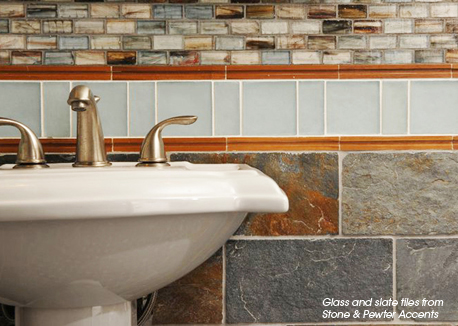Education is golden and knowledge is power. This is true in any industry or profession, but as it relates to tile and stone projects, educating professionals on all aspects of the implementation of correct procedures can only create a “win-win” situation for all involved. The percentage of failed projects would decrease, end-users would be delighted with the end-results, and more and more tile and stone would be consumed. Sometimes, however, even if tile and stone materials in a kitchen or bath are installed correctly, disaster could strike down the road if your clients are not alerted up front about three specific precautions. Here they are:
1. The need for waterproofing. Let’s say you present an amazing design solution for a client that includes a huge, spa-like bathroom outfitted with gorgeous granite countertops, glass-tile wall covering and flooring consisting of state-of-the-art porcelain tile. It’s pretty much common knowledge nowadays that glass tile is completely non-porous, and granite and porcelain only account for .05 percent water absorption. Does that mean that water won’t get through these surface finishes and attack substrate material, weakening it, causing potential mold and mildew problems? Not necessarily. In fact, in a worse-case scenario, it could even drip through the floor and ceiling below onto expensive electronic equipment, resulting in ruined components. Understand that even if today’s highest-performing grouting products are used, there still may be small cavities around shower nozzles, drains or somewhere else where water may find a way to seep through.
That’s why it makes sense both from a precautionary and financial standpoint (it only costs pennies per square foot) to consider waterproofing before installing the tile and stone. Over the years, the technology for production of waterproofing has progressed so that covering an entire room takes virtually no time or any specialized training. Some products are so user-friendly they do not require the use of fabric on floors, walls, coves or corners and may be simply brushed or rolled onto the areas to which tile will ultimately be installed. The latest in waterproofing options includes those made of self-curing liquid rubber polymer and sheet-applied rubber products, which form a flexible, seamless waterproofing membrane that are applied directly to a wide variety of substrates. Once they cure, tile, brick, stone and glass tiles may be installed directly onto these membranes. Some also contain antimicrobial product protection while others can function as anti-fracture membranes.
 Some of the latest waterproofing products do not require the use of fabric on floors, walls, coves or corners and may be applied directly onto a bathroom substrate. These include Laticrete’s HydroBan, a self-curing liquid rubber polymer that forms a flexible, seamless waterproofing membrane.
Some of the latest waterproofing products do not require the use of fabric on floors, walls, coves or corners and may be applied directly onto a bathroom substrate. These include Laticrete’s HydroBan, a self-curing liquid rubber polymer that forms a flexible, seamless waterproofing membrane.2. Some stones look good, but aren’t apropos for bathrooms. Know your stones. What you don’t want is a gorgeous representation of Mother Nature’s best that after one year looks as if it has morphed into Mother Nature’s worst. Educate your customers on which stones not only look good, but will perform at optimal levels. Obviously, high-density, low-porosity granite and quartz will work well for most floors. However, some softer stones, such as limestone and marble, may be better suited for vertical use or low-traffic floor use only. There are some visually stunning natural stones (such as high-polished dark marbles) that may negatively stun you with their inability to maintain their original appearance in a very short time if used in an inappropriate application.
Some of the beautiful green marble products, which look great on the facades of indoor mall jewelry stores for example, are simply not recommended for wet area installations. Polished marble, limestone and other stones that are not as dense as granite are easily scratched and stained. Just think of all the various solutions—shampoo, nail polish remover, various soaps—that may be harmless to humans but can actually deform and de-glamorize natural stone, even if it has been completely sealed. It makes sense to know which stones have predictable behavioral characteristics and specify them accordingly.
3. Don’t doubt the grout. As touched upon earlier, grout options—such as new generation epoxy grout and high-performance polymer-fortified cement-based grout—when responsibly selected, can be as strong, or stronger, and more non-porous than the tile or stone itself. Don’t forget that over the years, good old-fashioned sand-and-cement grouting products have had pigments added to them resulting in myriad color options to complement any tile installation.
In fact, lot of installation professionals still prefer sanded grout, as that’s what they were weaned on and, to this day, still insist upon using. But caveat emptor, there are certain installations where it is simply verboten to even consider using sanded grout! In the last decade, beautiful and highly colorful glass tile has enjoyed a strong re-emergence as a high-level design material. No one denies its beauty, but the last thing anyone wants to do is scratch its surface, which can be easily done by mistakenly electing to contrast its glossy appearance with a sanded grout. In some cases, a latex-fortified Portland-cement-based unsanded grout would be the better selection.
Today’s designers have a great many materials from which to create dream bathrooms for their clients. Whether ceramic, porcelain,
glass, metal and stone or a combination of multiple materials, all can work together to produce
incredibly unique design statements that also perform at high
levels for years to come. Just as long as proper installation is observed, appropriate materials are specified and the right precautions are taken, both enduring functionality and beauty are within reach.
—Arthur Mintie is director of technical services for Laticrete International, Inc.









